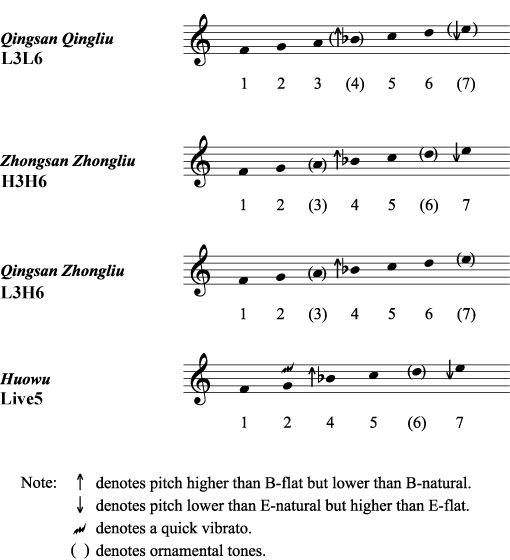|
1. Chaozhou Modal Theory "Mode" as a musicological concept has always been problematic. It is associated cross-culturally with a wide range of musical phenomena such as the Arabic maqam, Indian raga, Persian dastgah, Javanese pathet, Chinese diao, all of which possess significant differences between them Powers (1980). Within the realm of Chinese music, diao, the Chinese term for mode, is no less problematic because the parameters used to define it tend to vary from one historical period to another and from one genre and regional music tradition to another. For example, in modal theories from the Song and Ming dynasties, absolute pitch, scale and hierarchy of pitches seem to be the main determining factors of diao (Pian 1967 and Lam 1988). In qin zither music, in addition to these three factors, ornamentation, melodic motifs, range, tessitura, register, and kinesthetic and timbral aspects are the parameters that prove to be significant in mode identification and differentiation (Yung 1984; Bernoviz 1996). In Guangdong xiaoqu, the sizhu tradition native to the Pearl River delta area centered in Guangzhou (Canton), the tuning of the open strings of bowed instruments play an important role in defining mode along with scale, hierarchy of pitches, melodic contour and recurring melodic motifs, (Ye 1983:161; Li 1987:31). Given the varying criteria of what constitutes diao, it is therefore important to specify how the concept is defined and understood within both theoretical and performance contexts of Chaozhou xianshi. In Chaozhou music, scale, pitch ornamentation, pitch temperament, intervallic pattern and the recurrence of characteristic melodic motifs are the important parameters for distinguishing one modal variant of a given tune from another. The pitch of the key-note or initial and cadence tone is not considered important as a modal determinant.2 This is in contrast with the modal systems of the more mainstream Chinese folk music traditions wherein the beginning tone and the particular intervallic permutation of the pentatonic scale series that it generates identify the mode. The basic building block of Chaozhou xianshi is an anhemitonic pentatonic scale series consisting of the scalar degrees 1, 2, 3, 5 and 6, which are referred to using sol-fa syllables as do, re, mi, sol, and la respectively (Figure 1). Theoretically, the scale can be built on any of the twelve absolute pitch classes that constitute the standard tonal gamut. But in practice, Chaozhou xianshi musicians often designate F as 1 or do, resulting in a scale with the following pitches: F, G, A, C and D.3 The configuration of this basic pentatonic scale gets varied during performance with the frequent addition of two other tones, designated as fa (4) and ti (7), which are used as passing tones or interchanged with mi (3) and la (6) respectively as ornamental tones to achieve modal changes within the basic pentatonic framework (see Figure 1). Figure 1:Tonal material of the four most
common Chaozhou modes
Three kinds of seven-tone scales and one six-tone scale have come to be established, serving as the basis of particular diaoti from which others have presumably been generated . The first of the seven-tone Chaozhou modal scales is called Light 3 Light 6 (L3L6 qingsan qingliu, see Figure 1). Its name derives from the light (qing) vibrato on the tones designated as la (6) and mi (3), which correspond to san and liu respectively in the Chaozhou xianshi notation system known as ersipu, "two-four notation".4 Apparently primarily designed for the zheng zither although also employed by the other xianshi string instruments, ersipu makes use of the Chinese character symbols for numbers two to eight (er, san, si, wu, liu, qi and ba, respectively) to indicate the position of individual strings of the pentatonically tuned instrument (Table).5 "Qingsan qingliu" thus literally means to lightly vibrate the strings corresponding to san (la) and liu (mi) to produce a slight vibrato without raising their pitches. The inverse of L3L6 is the Heavy 3 Heavy 6 (H3H6 zhongsan zhongliu) modal scale. Its name derives from the heavy (zhong) pressure exerted on the strings corresponding to san and liu on the zheng zither so as to raise the pitches approximately three-quarters of a whole tone, thereby producing the two non-pentatonic tones, ti (7) and fa (4). In tune variants in this mode, these two tones function as structural tones and fall on strong beats, while la (6) and mi (3) function as ornamental tones and fall on weak beats. The reverse is true in the L3L6 mode wherein la and mi function as the structural tones, while ti and fa function as ornamental tones (Figure 1). A hybrid heptatonic scale resulting from the combination of the characteristics of the two preceding modal scales is the L3H6 modal scale. As its name suggests, its structural tones are produced by lightly vibrating the string corresponding to san (la) and thereby maintaining its pitch, and heavily pressing the string corresponding to liu (mi) and thereby raising its pitch and producing fa. The tones ti and mi function as ornamental tones in tune variants in this mode (Figure 1). According to many of my musician informants, the six-tone modal scale called "Live5" (huowu) perhaps best represents the essence or local flavor (xiang wei) in Chaozhou xianshi music. It features a highly ornamented tone which is produced by executing a rapid vibrating action on the string of the zheng zither corresponding to the tone designated as wu (the scale degree 2 or re ) in the two-four notation (see Table). This results in a fast vibrato on that particular pitch, hence the name huowu (literally "to make the wu pitch alive"). Aside from the highly ornamented wu (re), the tones corresponding to ti (7) and fa (4) function as structural tones in tune variants in this mode, while the tone corresponding to la (6) functions as an ornamental tone. The Live5 modal scale basically has the same tonal material as the H3H5 modal scale except for the absence of the tone corresponding to mi (3) (see Figure 1).
|
||||||||||||||||||||||||||||||||||||||||||||||||||||||||||||
